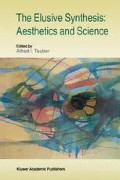Abstract
Since Plato, aesthetic experience was understood as the encounter with the self-manifesting (self-expressing) authenticity of being. At the same time, the Western intellectual traditions were inclined to view mathematics as perhaps the purest form of human rationality. Since rationality was viewed as revealing of the authenticity of beings, the unity of mathematical and aesthetic experiences often appeared to philosophers as self-evident.
Access this chapter
Tax calculation will be finalised at checkout
Purchases are for personal use only
Preview
Unable to display preview. Download preview PDF.
References
Plotinus, The Enneads. I, 6, 6.
Heidegger, M., ‘Der Ursprung des Kunstwerkes’, Holzwege, 2nd. ed. (Frankfurt a.M.: Klostermann, 1952), pp. 7–68.
Heidegger, M.‘The origin of the work of art’, in M. Heidegger, Poetry, Language, Thought, trans, by A. Hofstadter (New York, Hagerstown, San Francisco, London: Harper, 1975), pp. 15–87.
Heidegger, M., Kant and the Problem of Metaphysics, trans, by James S. Churchill (Bloomington: Indiana University Press, 1962), pp. 226–238.
Heidegger, M., ‘Die Zeit des Weltbildes’ (The age of the world as view), in Holzwege (Frankfurt a.M.: V. Klostermann, 1953), pp. 69–105, English trans, by Marjorie Grene, Measure, II, 1951, pp. 269–284.
Akhutin, A. V., Istoria Principov Fizicheskogo Experimenta: Ot Antichnosty do 17 Veka (History of the Principles of Experimentation in Physics: from Antiquity to 17th century) (Moscow: Nauka, 1976).
Bibler, V. S., ‘Galilei i logika myshleniay novogo vremeni’ (Galileo and the logic of thinking of modernity), in Mekhanika i Tsivilizatsiya 17–18 vekov (Mechanics and the Civilization of the 17th-18th centuries) (Moscow: Nauka, 1979), pp. 448–518, Bibler, V. S., ‘Kant i logika eksperimenta’ (Kant and the logic of experiment), Voprosy istorii estestvoznaniya i tekhniki, 1987, 1.
Merleau-Ponty, M., Signs, trans, by Richard C. McCleary (Evanston, Ill.: Northwestern University Press, 1964), p. 84.
Lenoir, T., The Strategy of Life. Teleology and Mechanics in Nineteenth Century German Biology (Dordrecht/Boston/London: D. Reidel Publishing Company, 1982).
Heidegger, M, ‘Der Ursprung des Kunstwerkes’, p. 74.
Kant, L.,Metaphysische Anfangsgruende der Naturwissenschaft, Vorrede, in Kant Werke (Darmstadt: Wissenschaftliche Buchgesellschaft, 1975), Bd. 8, p. 14.
Kline, M., Mathematics. The Loss of Certainty (New York: Oxford University Press, 1980), p. 341.
Kant, I., Critique of Pure Reason, trans, and ed. by F. M. Mueller (London: Macmillan & Co. Ltd., 1934), p. 572.
Carnap, R., The Logical Structure of the World; Pseudoproblems in Philosophy, trans. by Rolf A. George (Berkeley: University of California Press, 1967).
Goodman, N., Ways of Worldmaking (Indianopolis: Hackett Pub. Co., 1978).
Kant, I., Critique of Pure Reason, trans, and ed. by F. M. Mueller (London: Macmillan & Co. Ltd., 1934), pp. 572–592.
Lachterman, D. R., The Ethics of Geometry. A Genealogy of Modernity (New York, London: Routledge, 1989), pp. 10–11.
Cohen, P. J., Set Theory and the Continuum Hypothesis (New York: W. A. Benjamin, 1966), p. 1.
Kant, I., Opus Postumum, Engl, trans, by E. Foerster and M. Rosen, ed. by E. Foerster (Cambridge University Press, 1993), p. 139. Chapter 11(251,271-273)
Editor information
Editors and Affiliations
Rights and permissions
Copyright information
© 1996 Kluwer Academic Publishers
About this chapter
Cite this chapter
Chernyak, L., Kazhdan, D. (1996). Kant and the Aesthetic-Expressive Vision of Mathematics. In: Tauber, A.I. (eds) The Elusive Synthesis: Aesthetics and Science. Boston Studies in the Philosophy of Science, vol 182. Springer, Dordrecht. https://doi.org/10.1007/978-94-009-1786-6_10
Download citation
DOI: https://doi.org/10.1007/978-94-009-1786-6_10
Publisher Name: Springer, Dordrecht
Print ISBN: 978-0-7923-4763-7
Online ISBN: 978-94-009-1786-6
eBook Packages: Springer Book Archive

